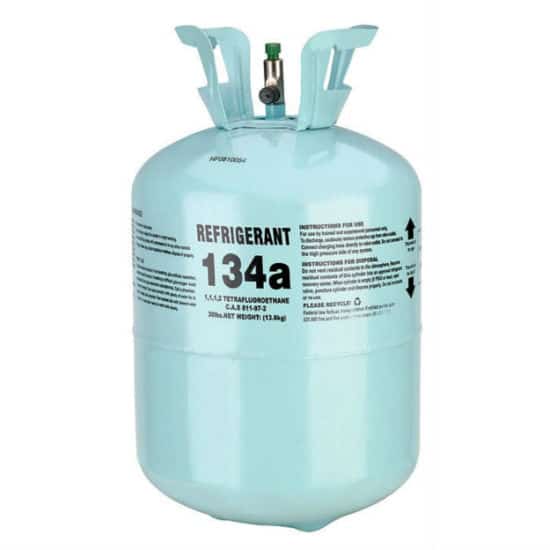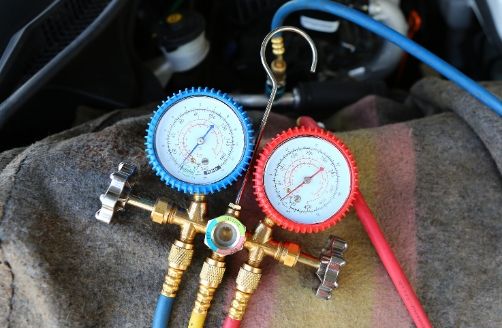| Ambient Temperature (°F) | Low Side | High Side |
| 110° | 50-55 psi | 335-345 psi |
| 105° | 50-55 psi | 325-335 psi |
| 100° | 50-55 psi | 300-325 psi |
| 95° | 50-55 psi | 275-300 psi |
| 90° | 50-55 psi | 250-275 psi |
| 85° | 50-55 psi | 220-250 psi |
| 80° | 45-50 psi | 175-220 psi |
| 75° | 40-45 psi | 150-175 psi |
| 70° | 35-40 psi | 140-165 psi |
| 65° | 25-35 psi | 135-155 psi |
Being confident with your A/C compressor means it is operating at its optimum capacity.
But, being an element in refrigeration, it can also develop some malfunction.
If such a situation presents itself, you will need the interpretation of your A/C compressor unit.
A qualified technician can do that job for you. The technician should have the right tools and information about the A/C compressor.
One of the tools needed is an information tool called the pressure chart. The pressure chart plays a vital role in identifying the problem in an A/C compressor unit.
In this article, let us look at one type of a pressure chart called R134a low side pressure chart.
Keep reading as you seek to know what R134a low-pressure chart is
Before we define the R134a low side pressure chart, let us understand what r134a stands for.
So,
What does R134a mean?

R134a is a refrigerant used in a wide range of home appliances or industrial appliances. These home appliances come fitted with a refrigeration unit known as the compressor.
Inside this compressor is a refrigerant R134a. The refrigerant enables the compressor to perform its function well.
Fitting of a gauge /meter helps to understand the regular operation of this component.
The meter displays the pressure readings against the temperature readings of the refrigerant. In this case, R134a is the refrigerant.
The recording of these readings is on a table with three columns. We have the temperature column, low side, and the high side pressure column.
Usually, we refer to the table as the pressure chart. In this case, because the refrigerant is R134a, our chart will be the R134a pressure chart.
R134a pressure chart indicates the pressure-temperature relation to R134a refrigerant.
The r134a chart is in two forms,
- R134a low side pressure chart.
- R134a high side pressure chart.
The gauge/meter installed on the refrigeration component contains two meters/gauge. We have a low-pressure gauge and the high-pressure gauge.
For the low side pressure chart, the readings are from the low side meter. Similarly, the high side pressure chart recordings are from the high side gauge or meter.
So,
What is a R134a Low Side Pressure Chart?

It is a chart detailing the relationship between pressure and temperature on the lower side of the A/C compressor.
Is the R134a low side pressure chart important? Yes.
How?
The technician uses this chart to determine whether the A/C compressor needs a refrigerant recharge.
Similarly, it tells you if the compressor requires a replacement. Hence, it determines the condition of the A/C compressor system.
To identify that the A/C compressor unit is operating at its optimal, the technician uses the R134a low side pressure chart.
Knowing what the R134a low side pressure chart is a daunting task. Similarly, to interpret the reading on the charts is never easy. Remember, the measure is against pressure.
Therefore, you must understand what each reading means.
When interpreting this reading, you compare both the low side and the high side of the chart. But this article is about the R131a low side pressure chart.
So, let us focus on the readings on the low side. Remember, we are comparing the reading of pressure against temperatures.
How to Read an R134a low Side Pressure Chart

Well, let me walk you through the whole process.
Remember this; a well-performing compressor should have low readings on the low side pressure chart.
It will indicate that the compressor is clean, and there is a maximum flow of air.
This process will make you understand and interpret the readings on the r134a low-pressure chart.
- On the low side, the pressure is low as compared to high temperature. It should show you two things
- The A/C compressor system is not engaged. Therefore there is a changing displacement in its operation.
- The compressor operation could be failing. So you need to replace it with another one.
- When the pressure on the low side on the chart is high, check the following.
- Check the condenser fan. It might not be running. The dirt is clogging, and so there is an obstruction in the flow of air.
- There also could be an obstruction of the refrigerant flow in the compressor.
- On the low side of the chart, the pressure is low while the temperature is high. It should mean the system is not operating on its optimal capacity.
- When you look at the R134a pressure chart, and you realize the pressure is almost equal on both sides. Consider the following.
- The A/C compressor displacement function is not working, and so it needs checking
- The expansion valve in the A/C might not be working.
In other words, the A/C compressor could be failing internally.
Wait a minute, I know by now you are wondering and asking yourself,
What are the Normal Operating Pressures for R134a?

The pressure for an ordinarily operating R134a is between 22 and 57 pounds per square inch (PSI).
Remember, there are two sides to the chart; we have the low and the high.
Therefore in a normal R134a, the low-pressure side is 90 degrees or less, and the PSI should be close to 30.
Having gone through all the above details, you are still wondering,
Why Is my Low Side AC Pressure High?
As I had mentioned in the interpretation of the reading part above, point number two to be precise.
High pressure on the low side of the pressure chart is not a good indicator. In other words, the A/C compressor unit of your appliance could be failing; therefore, it needs a service.
On a closer look, the technician should be able to note the following,
- The condenser fan might not be running due to clogged dirt. So there is an obstruction in the flow of the air.
- The refrigerant could not be flowing properly.
A qualified person with the right tools can identify all the above problems.
Conclusion
The r134a low-pressure chart is essential to every technician. Whether it is for home inspection and interpretation or commercial interpretation
The table helps inspect, identify, and solving problems arising from the readings. If you are a technician, Consider having it at all times.








